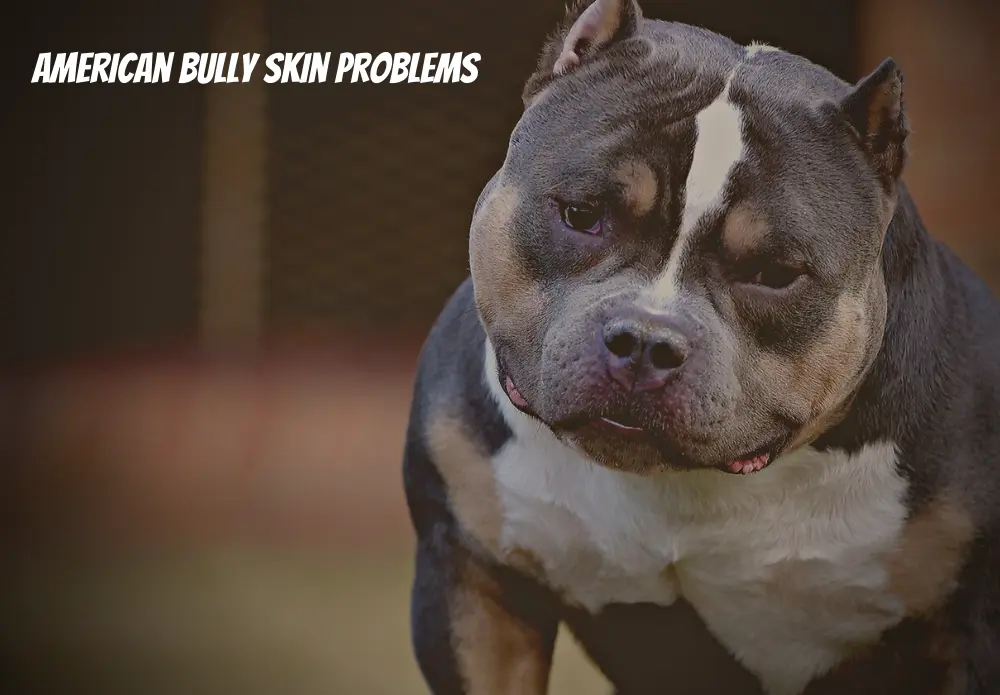American Bullies make for some of the best pets as they are loyal and affectionate, and this breed has many benefits. However, they are very vulnerable to getting skin diseases or other problems.
To keep your American Bully healthy, you will have to be on the lookout for some common skin issues that could harm your American Bully.
Some Common Skin Problems in Dogs
All dogs are susceptible to various skin diseases, which are very common. Many people don’t know these common diseases and often mistreat their dogs and blame the breed for these defects.
Here are a few skin diseases common in dogs:
- Skin Sores
- Skin sores or skin lesions
- Dry skin/flaky skin/scaly skin
- Rashes
- Lumps
- Redness
- Dandruff
- Bumps
- Intense itching
- Excessive licking
- Excessive scratching
- Hair loss/bald patches
- Hot spots of inflamed skin (also known as acute moist dermatitis)
Causes of Skin Problems in American Bully
Even though American Bullies have short coats, they still get skin problems mainly due to their extra skin that folds around to trap moisture, bacteria, and debris.
Moisture trapped in the skin folds can cause infections and sometimes develop dry skin. Other causes of skin problems are allergens, diet, dehydration, uncleanliness, and inheritance.
Most people dont look after their American Bully properly because they have short coats and let their dogs walk around dirty. This leads to bacteria building up and skin infections such as yeast and fungal infections.
Dehydration, skin mites, and diet can lead to dryness, dandruff, hair fall, and sensitive skin. Such environmental factors can be controlled to some extent by the owner.
The last and main factor is allergens, which are all around us and hard to avoid. Allergies are inherent, and there is no cure; however, you can prevent them by taking all the proper precautions.
Here are a few common skin problems in American Bullies.
Common Skin Problems in American Bully
American Bullies, like any other breed, can also develop skin problems. The most common Bully skin issues are:
1. Canine Atopic Dermatitis (Allergies)
Canine Atopic Dermatitis (CAD), in simple words, is an allergic reaction. It is one of American Bullies’ most common skin problems, as they often have allergies inherited from generations.
CAD usually reveals itself when a Bully is six months to three years old, although it can occur later in a dog’s life due to overexposure.
The symptoms of CAD include itchy skin, scaly skin, and hair loss. Bullies with CAD will most likely pass down these allergies.
The most common allergens to trigger CAD are:
- Fleas
- Pollen
- Grass
- Mold and mildew
- Certain foods, including yeast
- Bacteria that naturally colonize a dog’s skin
2. Ichthyosis
Ichthyosis comes from a Greek word meaning “fish” since this disorder causes dry, flaky skin patches that look like fish scales. It is a hereditary condition, and its incurable.
Most American Bullies show signs of ichthyosis when they are young puppies.
3. Pyoderma and Intertrigo (Skin Fold Dermatitis)
Intertrigo is a type of pyoderma that depicts severe skin itch between a dog’s skin folds from scratching, excessive moisture and heat, and bacterial infections that root in warm, humid areas.
Intertrigo is a less severe form of skin fold pyoderma in medical classification. Both are called pyoderma, so if your veterinarian diagnoses your Bully’s skin condition as either, the treatment will be the same.
4. Yeast Infections
Yeast prefers to live in warm, dark, wet conditions, making your Bully’s skin folds prime real estate for these microscopic organisms.
The most common infection that American bullies suffer from is Yeast infection.
5. Fungal Infections
Skin-growing fungi are like yeast infection; add water, and you have a perfect recipe for fungal infection.
Fungal infections usually look identical to bacterial infections and pyoderma, and these conditions are normally present in a Bully’s skin folds, joints, paws, and ears.
Nonetheless, there are a few ways to distinguish both infections. So, let’s look at the signs of fungal infections:
- An acidic, yeasty smell
- Red tone on ears and skin folds
- Waxy, dark discharge surrounding the affected area
- Continuous itching, chewing, or rubbing
- Probablehair loss or skin flaking
6. Skin Mites Such
Demodicosis mites, also known as red mange mites, are generally found on dogs with many skin folds.
These mites often live on dogs without any issues, but if they begin to reproduce and spread quickly, they could induce some discomfort to your American Bully.
Mites are more common in young Bullies and puppies since they have not yet developed a robust immune system. However, they can plague adult Bullies, too.
Demodicosis mites are microscopic, which makes them extremely difficult to specify.
7. Eczema
Eczema is a skin issue that is very common in dogs. However, this skin problem is not a disease. Rather, it is a sign of a more important problem, and most of the leading causes of eczema are very common in American bullies.
Eczema can be onset by other diseases such as CAD, pyoderma, infections, and mites. These other problems can irritate the skin so much that it forms painful, itchy spots where the skin either oozes or dries out to fight another infection, eliminate an allergen, or eradicate pests.
Still, other factors may cause eczema, such as a lack of fundamental vitamins, contact with toxic plants or chemicals, or extremely hot or dry weather.
Diagnosis and Treatment
American Bully will sometimes show signs of skin problems, and you must be vigilant to detect and diagnose them early.
The symptoms of these diseases are as follows:
Symptoms
1. Canine Atopic Dermatitis
- Consistent and painful itching
- Redness and lesions near the face, ears, belly, and butt, and the inside of arm, paw, and leg joints
- Bacterial or yeast infections
- Eczema
2. Ichthyosis
- Affected puppies have stringy hair and a thin, rough coat
- Dense, calloused patches of dry skin with the tiniest hair growth
- Swollen foot pads
- Dandruff
- Oily flaking skin that is hard to remove or clean
- Potential cracks in the dry skin, which may cause bleeding and oozing
3. Pyoderma and Intertrigo
- A rancid stench emanating from the dog’s folds of skin
- High heat and dampness or oozing in the skin folds
- Hair fall
- Inflammation and redness in the skin’s creases
4. Mite Infestation
- Dandruff and hair loss in the afflicted area
- Itching
- Angularity and color
- Skin infections caused by bacteria or fungi in the afflicted area
Treatment
Witnessing your precious American Bully suffering from skin problems can be difficult. If you notice any issues, schedule an appointment with your dog’s vet for a consultation.
Depending on your dog’s needs and situation, antibiotics, allergy medicines, creams, and ointments can address their concerns.
If your dog’s vet prescribes antibiotics, ensure you understand the precise medicine’s dosage, frequency, and duration. These factors can influence how well your Bully responds to the treatment and how positively they heal.
Make sure your Bully takes the entire course of medication, even if it seems they are healed, to eradicate the bacteria and allow your dog to recover fully.
In some cases, routine bathing and thoroughly washing the impacted areas can make a difference for your American Bully.
Numerous over-the-counter or prescription shampoos can reduce itching or irritation for your dog. Dietary changes could also improve conditions for your Bully, depending on the source of their skin irritation.
You can also add omega-3, Vitamin A, B, C, and D to your Bully’s diet to help improve their immune system.
Prevention and Management
It’s a famous phrase that prevention is better than treatment, which is also valid for this situation. If you dont want to deal with the skin issues of an American Bully, you must take precautions in caring for your Bully.
Here are a few ways you can avert and manage skin issues in American Bullies:
1. Regular Brushing Routine
Since American Bullies have short coats, it’s easier to detect loose hairs and uneven patches when you pet them. If you don’t brush them regularly, you will find loose hairs on clothes, furniture, food, and anything your Bully comes in contact with.
Thus, a regular brushing routine is crucial as it minimizes shedding and improves skin. You should brush your American Bully at least once a week.
Doing so will reduce dirt, debris (pollen, food, etc.), dander, and lice buildup/growth. Regular brushing will help your dog secrete natural protective oils to minimize itching and scratching.
2. Proper Diet and Water
Proper nourishment is the key to preserving the good health of your Bully, not just its coat and skin. Therefore, you must ensure it gets the right amount of macros, especially high-quality proteins.
You should ask your vet to suggest the best dog food products regarding nutrients, vitamins, and meal types.
Secondly, you must ensure your American Bully is hydrated, as dehydration usually leads to dry and flaky skin, which leads to disturbance and skin problems. So, ensure it has clean water in its living area.
3. Temperature Management
Like many dogs, American Bullies usually shed more frequently during the summer. Therefore, one smart way to decrease shedding is by keeping them cool.
Of course, this requires keeping them indoors in a controlled environment for long periods, which could limit their playtime and exercises.
However, you can compensate for this lost time by taking them outdoors during the colder hours, such as early mornings or after sunset.
4. Regular Vet Consultations
As said above, American Bullies are highly liable to developing skin issues caused by food or allergies. As a result, American Bullies undergo hair loss and more shedding than average.
Therefore, you should proactively consult your vet to determine your Bully’s allergy’s source trigger. This way, you can choose which animal proteins or carbs to steer clear off.
For example, you can opt for chicken if your Bully is allergic to beef. Moreover, you can proactively store your medicine cabinet with your Bully’s allergy and skin medication for self-administration/application.
5. Avoid Stress and Anxiety
If you don’t know, Bullies are prone to excessive shedding when stressed or anxious. The most common catalysts include boredom, fear, and distress.
For instance, they could start excessively shedding if you shift into a new house or adopt another dog.
Switching their daily routine by restricting their playtime or activity due to school or work schedules could make them more anxious.
6. Proper Bathing and Showering
American Bullies don’t need to bathe as often as long-haired breeds. Too much bathing could reverse affect their skin and coat health by removing the natural moisturizing oils from their skin, encouraging dryness, dandruff, and itching.
Therefore, you should only bathe Bullies once a month during summer and 2-3 months during the winter. Secondly, inappropriate shampoo can also lead to shedding and skin issues.
Many Bullies have sensitive skin and allergies. Therefore, they need hypoallergenic shampoos. So, communicate with your vet to find the best-suited shampoo for your dog.
FAQs – Frequently Asked Questions
Do American Bullies Have Skin Issues?
American Bullies, like other dog breeds, are susceptible to skin issues. American Bullies need more care than normal dogs as they have thin coats and a lot of skin folds that can develop skin issues rapidly.
What Are American Bullies Mostly Allergic To?
The most common allergens are:
- Fleas
- Pollen
- Grass
- Mold and mildew
- Certain foods, including yeast
- Bacteria that colonize a dog’s skin
Why Is My American Bully So Itchy?
Your American Bully may be allergic to environmental triggers, like pollen, mold spores, or dust mites. If the itch remains consistent, contact your vet immediately.
How to Treat Bully Bumps?
Take these quick steps to help your Bully with bumps:
- Visit a vet for skin care medication.
- Wash your Bully 3 times a week with the prescribed shampoo.
- Give proper and timely medication.
- Detect and avoid any allergens present near the Bully or the house.
Conclusion
Allergies are common in American Bullies but are treatable and easily prevented. If you believe your Bully has allergies, contact your vet and try to avoid anything that can further their misery.
I hope this article was helpful and you will do everything to keep your Bully’s skin in pristine condition.






